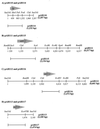Screening of environmental DNA libraries for the presence of genes conferring lipolytic activity on Escherichia coli
- PMID: 10877816
- PMCID: PMC92121
- DOI: 10.1128/AEM.66.7.3113-3116.2000
Screening of environmental DNA libraries for the presence of genes conferring lipolytic activity on Escherichia coli
Abstract
Environmental DNA libraries prepared from three different soil samples were screened for genes conferring lipolytic activity on Escherichia coli clones. Screening on triolein agar revealed 1 positive clone out of 730,000 clones, and screening on tributyrin agar revealed 3 positive clones out of 286,000 E. coli clones. Substrate specificity analysis revealed that one recombinant strain harbored a lipase and the other three contained esterases. The genes responsible for the lipolytic activity were identified and characterized.
Figures



References
-
- Alon R N, Gutnick D L. Esterase from the oil-degrading Acinetobacter lwoffii RAG-1: sequence analysis and over-expression in Escherichia coli. FEMS Microbiol Lett. 1993;112:275–280. - PubMed
-
- Arpigny J L, Jendrossek D, Jäger K-E. A novel heat-stable lipolytic enzyme from Sulfolobus acidocaldarius DSM 639 displaying similarity to polyhydroxyalkanoate depolymerase. FEMS Microbiol Lett. 1998;167:69–73. - PubMed
-
- Blow D. More of the catalytic triad. Nature. 1990;351:694–695. - PubMed
Publication types
MeSH terms
Substances
Associated data
- Actions
- Actions
- Actions
- Actions
LinkOut - more resources
Full Text Sources
Other Literature Sources

